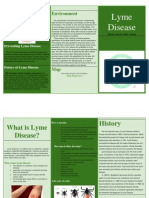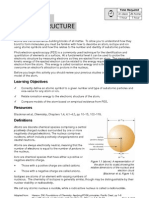Atomic Structure and Periodic Table
Atomic Structure and Periodic Table
Uploaded by
eugene_970418755Copyright:
Available Formats
Atomic Structure and Periodic Table
Atomic Structure and Periodic Table
Uploaded by
eugene_970418755Original Description:
Copyright
Available Formats
Share this document
Did you find this document useful?
Is this content inappropriate?
Copyright:
Available Formats
Atomic Structure and Periodic Table
Atomic Structure and Periodic Table
Uploaded by
eugene_970418755Copyright:
Available Formats
Atomic Structure and Periodic Table
Earlier, weve studied that elements are the purest substances of all. And each element has its own type of atoms. When scientists first discovered the atom, they believed it was a spherical structure like marbles. Later on other scientists discovered that there the atom is made up of even smaller sub-atomic particles.
The Atomic Structure:
It was discovered that an atom is made up of three types of subatomic particles; these are protons, neutrons and electrons. It was also discovered that in the center of an atom, there is a Nucleus which is made up of protons and neutrons. Around the nucleus there are energy shells in which electrons are. Electrons are always orbiting the nucleus in the energy shells. Protons and Neutrons are said to be Nucleons because together they make the nucleus. Each type of these sub-atomic particles has its own physical properties which are explained in this table: Particle Proton Neutron Electron Symbol p n e Mass 1 1 1/200 (Negligible) Charge +1 no charge -1
These physical properties tell us several factors:
The mass of the atom is concentrated in the nucleus; this is because the mass of an electron is negligible, A neutron has no charge, it is neutral, An atom is also neutral; this is because it always contains as much positive protons as negative electrons.
The mass of the sub-atomic particles is in atomic mass unit (AMU). This is because they are so light that they cant be measured in grams. There are two numbers given to each type of atoms: Atomic/Proton Number: it is the number of protons in an atom. And since an atom has an equal number of protons and electrons, it is the number of electrons in the atom too. Mass/Nucleon Number: it is the number of protons + number of nucleons in the nucleus of an atom. It is called mass number because its value is also mass of the atom.
If the atomic number is the number of protons, and the mass number is the number of protons and neutrons, then subtracting the proton number from the mass number will give you the number of neutrons in the atom. When we represent the atom of an element, we give it a symbol of one or two letters where the first letter is always in capitals and the second one is in lowercase. The mass number goes above the symbol and the atomic number goes below the symbol. Example:
4He2
This represents the Helium Atom, Its symbol is He, Its mass number is 4, Its atomic number is 2, It has 2 protons, 2 neutrons (4 - 2 = 2), and 2 electrons.
24Mg12
This represents the Magnesium Atom, Its symbol is Mg, Its mass number is 24, Its atomic number is 12, It has 12 protons, 12 neutrons (24 - 12 = 12), and 12 electrons.
Always remember that: An atom has an equal number of positive protons and negative electrons which makes it neutral in charge
The Electronic Configuration of Atoms:
Electrons are arranged in energy shells or energy levels. But each energy shell can hold up to a certain amount of electrons.
1st energy shell holds up to 2e, 2nd energy shell holds up to 8e, 3rd energy shell holds up to 18e, but stable with only 8e.
If an atom has its 3rd energy shell holding 8e, if it receives 2 more they go to the 4th energy shell. If further 10e are received, they go to the 3rd energy shell making it saturated with 18e.
Valency electrons are the electrons in the outer most energy shell. Electronic arrangments in some elements:
Carbon
Lithium
The Periodic Table of Elements:
The periodic table is a table containing all elements arranged in ascending order from the one with lowest atomic number to the one with highest atomic number.There are there are 8 vertical groups (Columns) in the periodic table. The group number is equal to the number of electrons in the outer most energy shell of the atoms of the elements in the group. This is why elements of the same group share the same chemical properties.There are seven horizontal periods (rows) in the periodic table. The period number is also the number of occupied energy shells in the atoms of the elements in the period.So if an element has 3 valence electrons, it will be in group 3. And if it has 4 occupied energy shells, it will be in period 4. We have two types of elements in the periodic table. These are Metals and Non-metals. As we move in the periodic table from the left to the right, the metallic properties of elements decrease. Metals include Magnesium, Calcium, and Sodium. Non-metals include Carbon, Oxygen and Chlorine. All metals are solid. All non-metals are either solid or gas, except for bromine which is liquid.
Silver appears as a lustrous white metal Metals and non-metals have different Physical properties:
Bromine is a non-metal
Physical Property: State In Room Temperature Density Appearance Melting Point Boiling Point Malleability Ductility Electrical Conductivity Heat Conductivity Sonority
Metals Solid (Except Mercury, Liquid) Very Dense (Except Group 1) Shiny, Most Are Grey Except Copper And Gold High (Except Groups 1 & 2) High (Except Groups 1 & 2) Hard And Malleable Ductile Conductors Good Sonorous
Non-Metals Solid-Gas (Except Bromine, Liquid) Low Density Most Are Dull (Except Diamond Low (Except Diamond-Graphite) Low (Except Diamond-Graphite) Soft And Brittle Not Ductile Poor Conductors (Except GraphiteSilicon) Very Poor Non-Sonorous
Malleability: If a metal is malleable it means it can be hammered into shapes without being broken. Ductility: If a metal is Ductile it means it can be pulled into wires. Sonority: If a metal is sonorous, it means it makes a pleasant sound when struck. Metals and non-metals also differ in chemical properties: Metals They have either 1,2 or 3 valence electrons They lose electrons forming positive ions They are reducing agents They form basic or amphoteric compounds Forms ionic compounds with nonmetals Non-Metals They have either 4,5,6,7 or 8 valence electrons. Except helium which has 2. They gain electrons forming negative ions They are oxidizing agents They form acidic or neutral compounds Form either ionic compounds with metals, or covalent compounds with other non-metals
You might also like
- NJP 1200 Series Automatic Capsule Filling Machine PDFDocument53 pagesNJP 1200 Series Automatic Capsule Filling Machine PDFtrungvu67% (6)
- Lyme Disease Brochure TemplateDocument2 pagesLyme Disease Brochure Templatetburkle50% (2)
- Messiah TV SeriesDocument168 pagesMessiah TV SeriesPaul SavvyNo ratings yet
- This Is It. The Sign of The ApocalypseDocument7 pagesThis Is It. The Sign of The ApocalypseJerry VanoNo ratings yet
- Titanic Loss For TeslaDocument1 pageTitanic Loss For Teslasaucersource100% (1)
- A Level Physics PracticalsDocument95 pagesA Level Physics PracticalsRaiyan Bashar79% (14)
- Shenk's Ferry Wildflower Preserve BrochureDocument2 pagesShenk's Ferry Wildflower Preserve Brochureliquidity100% (1)
- Avicenna's Canon of MedicineDocument8 pagesAvicenna's Canon of MedicinelearnafrenNo ratings yet
- Eeooii de Capv English Exam Sample: Eaeko HeoakDocument16 pagesEeooii de Capv English Exam Sample: Eaeko Heoakestefania aranda jimenezNo ratings yet
- Worksheet 10 PDFDocument4 pagesWorksheet 10 PDFJosh FlorentinoNo ratings yet
- Integrative Management of Diabetic Foot Ulcer With Homoeopathy and Standard CareDocument7 pagesIntegrative Management of Diabetic Foot Ulcer With Homoeopathy and Standard Carezzqq789No ratings yet
- Glandular AffectionsDocument3 pagesGlandular AffectionsRajiv Ranjan SinhaNo ratings yet
- North Eastern Institute of Ayurveda & HomoeopathyDocument8 pagesNorth Eastern Institute of Ayurveda & HomoeopathyKirankumar MutnaliNo ratings yet
- Extra Healing 1Document71 pagesExtra Healing 1MURAPPANADNo ratings yet
- Periodicity PDFDocument153 pagesPeriodicity PDFijustwanawriteNo ratings yet
- 1897 Valcourt-Vermont Practice of Palmistry For Professional PurposesDocument8 pages1897 Valcourt-Vermont Practice of Palmistry For Professional PurposesmajikNo ratings yet
- Kirti Betai's Research IIDocument5 pagesKirti Betai's Research IIfsolomonNo ratings yet
- The True Meaning of The Law of Five Elements (Organs' Reciprocal Dependences and Their Practical Use)Document4 pagesThe True Meaning of The Law of Five Elements (Organs' Reciprocal Dependences and Their Practical Use)MOULIANNA8949No ratings yet
- Miasm BerkshireDocument20 pagesMiasm Berkshirehyder2oo9No ratings yet
- RashisWeekend 1 PDFDocument15 pagesRashisWeekend 1 PDFVinodh Kumar RamuNo ratings yet
- Solar SystemDocument6 pagesSolar SystemZohaib PervaizNo ratings yet
- The Health Revolution Episode 7Document15 pagesThe Health Revolution Episode 7Clive de CarleNo ratings yet
- Earth Human Energy SystemDocument24 pagesEarth Human Energy SystemHelpMePlease100% (1)
- Ingles Lost Book of NostradamusDocument5 pagesIngles Lost Book of NostradamusNibirutaNo ratings yet
- OctahedronDocument38 pagesOctahedronpraveenNo ratings yet
- Scientific Framework Homeopathy 2013Document69 pagesScientific Framework Homeopathy 2013oui ameeNo ratings yet
- Chinese AlchemyDocument5 pagesChinese Alchemyluxmundi100% (1)
- Traditional Medical Astrology 2Document3 pagesTraditional Medical Astrology 2tmn20110% (1)
- The Geometric Lectures of Isaac BarrowDocument246 pagesThe Geometric Lectures of Isaac BarrowBill CrombieNo ratings yet
- Myths and Scientific Explanations Behind Natural PhenomenaDocument36 pagesMyths and Scientific Explanations Behind Natural PhenomenaAshraful IslamNo ratings yet
- Astrology Scofield Where Is PersonDocument5 pagesAstrology Scofield Where Is PersonshadowgraphNo ratings yet
- Natural Disasters - Prediction Before Prevention The Catastrophe Theory - The Background To Georheology - DR Andrew M. DavieDocument6 pagesNatural Disasters - Prediction Before Prevention The Catastrophe Theory - The Background To Georheology - DR Andrew M. DavieChromaticghost2100% (1)
- Classical Planet - WikipediaDocument3 pagesClassical Planet - WikipediaNyx Bella DarkNo ratings yet
- The Suns Origin PDFDocument6 pagesThe Suns Origin PDFgamersgeneNo ratings yet
- Chapter 12 - Universal GravitationDocument26 pagesChapter 12 - Universal Gravitationascd_msvuNo ratings yet
- Astangata or Combustion ImpDocument18 pagesAstangata or Combustion Imptmn2011No ratings yet
- An Historical Geography of The Old and New Testament V I 1809Document416 pagesAn Historical Geography of The Old and New Testament V I 1809juliojk08No ratings yet
- The Problems With Passion ColorDocument9 pagesThe Problems With Passion ColorPalani MuruganNo ratings yet
- Cardinal PellDocument5 pagesCardinal PellWilliam Edgar SmithNo ratings yet
- Causative Nature of Cycles by PuruckerDocument2 pagesCausative Nature of Cycles by PuruckerWolfgangNo ratings yet
- Side Real Time-Basics2Document30 pagesSide Real Time-Basics2dombipinNo ratings yet
- Use of Coconut OilDocument5 pagesUse of Coconut OilRakeshKumarNo ratings yet
- Fibonacci Numbers and MusicDocument1 pageFibonacci Numbers and MusicCharity MastersNo ratings yet
- Nadi ReadingDocument5 pagesNadi ReadingSunilkumar DubeyNo ratings yet
- VITAL QUESTIONS AND ANSWERS - McCannDocument54 pagesVITAL QUESTIONS AND ANSWERS - McCannPaul CapellNo ratings yet
- On The Harmonic SeriesDocument22 pagesOn The Harmonic SeriesNganku Junior100% (1)
- Homeopathy Research Evidence Base 7-12-2017 PDFDocument214 pagesHomeopathy Research Evidence Base 7-12-2017 PDFGanesh ganguly GMNo ratings yet
- Activity 3 Handout: Sound Travels Through The Air in WavesDocument12 pagesActivity 3 Handout: Sound Travels Through The Air in Wavesapi-112265046No ratings yet
- Time - Internet Encyclopedia of PhilosophyDocument67 pagesTime - Internet Encyclopedia of Philosophyagf1001No ratings yet
- Stabilization Pluto, Uranus and Saturn This Summer FallDocument5 pagesStabilization Pluto, Uranus and Saturn This Summer FallReiki MasterNo ratings yet
- Mesopotamian Horoscopes PDFDocument26 pagesMesopotamian Horoscopes PDFGary DaoNo ratings yet
- The Genesis of PHI & ELECTROMAGNETIC & GRAVITATIONAL FORCESDocument15 pagesThe Genesis of PHI & ELECTROMAGNETIC & GRAVITATIONAL FORCESHector CharlottenNo ratings yet
- Human Body Systems ppt2016Document53 pagesHuman Body Systems ppt2016RoryKurniawan100% (1)
- Activity 1Document12 pagesActivity 1tlchewNo ratings yet
- The Tree of Life Basis of An Astrological Era: Stephen M. PhillipsDocument13 pagesThe Tree of Life Basis of An Astrological Era: Stephen M. PhillipspphuckNo ratings yet
- Arsenicum Album: GeneralitiesDocument19 pagesArsenicum Album: GeneralitiesShiva MaruNo ratings yet
- F.U.T.U.R.E Newsletter-July 1984Document5 pagesF.U.T.U.R.E Newsletter-July 1984Homers Simpson100% (1)
- 21 SimilarityBetweenQuantumMechanicsAstrologyDocument7 pages21 SimilarityBetweenQuantumMechanicsAstrologySudhir Kumar PandeyNo ratings yet
- Atoms, Elements and MoleculesDocument16 pagesAtoms, Elements and MoleculesshantaebabydolltaylorNo ratings yet
- Atoms and Elements: ObjectivesDocument5 pagesAtoms and Elements: ObjectivesAngel RingorNo ratings yet
- Chapter 3 Atomic Structure and Periodic TableDocument12 pagesChapter 3 Atomic Structure and Periodic TableAmmar RizwanNo ratings yet
- Atoms and IonsDocument13 pagesAtoms and IonsYousuf Al ManjiNo ratings yet
- Hsa Math Reference Sheet v2Document2 pagesHsa Math Reference Sheet v2eugene_970418755No ratings yet
- Edexcel GCE: Biology Biology (Human)Document24 pagesEdexcel GCE: Biology Biology (Human)eugene_970418755No ratings yet
- Advanced Level Mock ExamDocument10 pagesAdvanced Level Mock Exameugene_970418755No ratings yet
- Advanced Level Biology Unit 6 Mock ExamDocument12 pagesAdvanced Level Biology Unit 6 Mock Exameugene_970418755No ratings yet
- Specimen Module 2BDocument11 pagesSpecimen Module 2Beugene_970418755No ratings yet
- Specimen Module 4BDocument5 pagesSpecimen Module 4Beugene_970418755No ratings yet
- Zulu BeadworkDocument8 pagesZulu Beadworkeugene_970418755No ratings yet
- Practise TestDocument3 pagesPractise Testeugene_970418755No ratings yet
- Mock Exam - CieDocument13 pagesMock Exam - Cieeugene_970418755No ratings yet
- Biology Mock Exam Paper 1Document17 pagesBiology Mock Exam Paper 1eugene_970418755No ratings yet
- Monthly Exam-Animal NutritionDocument10 pagesMonthly Exam-Animal Nutritioneugene_970418755No ratings yet
- Transport in HumansDocument10 pagesTransport in Humanseugene_970418755No ratings yet
- Homeostasis: Temperature RegulationDocument3 pagesHomeostasis: Temperature Regulationeugene_970418755No ratings yet
- Physics - Revision Exam-3Rd TermDocument1 pagePhysics - Revision Exam-3Rd Termeugene_970418755No ratings yet
- Metals: The Reactivity Series of MetalsDocument9 pagesMetals: The Reactivity Series of Metalseugene_970418755No ratings yet
- Asexual ReproductionDocument15 pagesAsexual Reproductioneugene_970418755No ratings yet
- M-1 2024 SyllabusDocument2 pagesM-1 2024 Syllabusahmedamk42No ratings yet
- The Capacity of A Screw Conveyor Depends On The Screw DiameterDocument4 pagesThe Capacity of A Screw Conveyor Depends On The Screw Diameterprajesh_bilvaNo ratings yet
- Building AcousticsDocument11 pagesBuilding AcousticsSindhura Valluri100% (1)
- Chemical Bonding WS 05Document5 pagesChemical Bonding WS 05MessiNo ratings yet
- Lecture 1-Physical Methods in Bioinorganic ChemistryDocument45 pagesLecture 1-Physical Methods in Bioinorganic Chemistrytrungs2300034No ratings yet
- ArticleDocument3 pagesArticleMuhammad Syafiq Bin NorazamiNo ratings yet
- Shear Strength PDFDocument57 pagesShear Strength PDFGowtham Ragunathan0% (1)
- Me201: Mechanics of Solids: End Semester ExamDocument1 pageMe201: Mechanics of Solids: End Semester ExamMuzammil MuhammedNo ratings yet
- Test-1 (12JPCM01) JEE UpdatedDocument8 pagesTest-1 (12JPCM01) JEE Updatedatlokesh707No ratings yet
- EtdDocument319 pagesEtdHitarth J MashruwalaNo ratings yet
- Cerium in Ductile IronDocument2 pagesCerium in Ductile Ironvivek1312100% (2)
- Polymer Viscoelasticity 0824779045 PDFDocument902 pagesPolymer Viscoelasticity 0824779045 PDFTheodoros NiklanovitsNo ratings yet
- CS 6504-Computer GraphicsDocument54 pagesCS 6504-Computer GraphicsKARTHIBAN RAYARSAMYNo ratings yet
- Aperture AntennasDocument78 pagesAperture Antennashishamromi76100% (1)
- Instant Download Concepts of Elementary Particle Physics Michael E. Peskin PDF All ChapterDocument64 pagesInstant Download Concepts of Elementary Particle Physics Michael E. Peskin PDF All Chaptersaafynbeaa100% (4)
- STD: 5 Chapter - 13 & 14 Science Sem - 2 Study Material Purvesh SIR (PH) : 9429976149Document4 pagesSTD: 5 Chapter - 13 & 14 Science Sem - 2 Study Material Purvesh SIR (PH) : 9429976149purvesh2510No ratings yet
- Sesame Cake Incorporation On Cassava Starch Foams For Packaging UseDocument7 pagesSesame Cake Incorporation On Cassava Starch Foams For Packaging UseSchopenhauer MattiasNo ratings yet
- IETE Template JRDocument7 pagesIETE Template JRAshish Kumar0% (1)
- Cosmic Speed LimitDocument6 pagesCosmic Speed LimitALEXANDRA KATTAN HERNANDEZNo ratings yet
- CBSE Class 12 Physics Marking Scheme 2019-20Document24 pagesCBSE Class 12 Physics Marking Scheme 2019-20fociweNo ratings yet
- HT - Unit 1 - Final.Document40 pagesHT - Unit 1 - Final.Chanti DasariNo ratings yet
- 14 15 H2 Quantum Physics1 NotesDocument29 pages14 15 H2 Quantum Physics1 NotesAgus LeonardiNo ratings yet
- 2D NMR SpectrosDocument21 pages2D NMR SpectrosraisameongNo ratings yet
- Ntroduction: William Thomson, Lord KelvinDocument14 pagesNtroduction: William Thomson, Lord KelvinRaj KomolNo ratings yet
- Fluid Mech - Chap 8Document57 pagesFluid Mech - Chap 8hananNo ratings yet
- Chemistry Paper Class 11Document4 pagesChemistry Paper Class 11Manan SharmaNo ratings yet
- Statics Lec PPT Section 4.7-4.8Document23 pagesStatics Lec PPT Section 4.7-4.8Siti Khadijah Che OsmiNo ratings yet
- Lesson 5 - Electric FieldDocument19 pagesLesson 5 - Electric FieldGino CruzNo ratings yet









































































































